ralf | June 1, 2011 | Annual, dungeon, Jon Roberts
We’ve just released the June issue of the Cartographer’s Annual 2011, and we’re very happy to present another style created by map-making artist Jon Roberts.
This time we went for a dungeon/floorplan style and the result is really gorgeous again. Take a look at these beautiful maps: Continue reading »
2 Comments
ralf | May 12, 2011 |
Speaking of science fiction rpgs and maps done in Cosmographer 3 in our previous post…
I recently had the pleasure to create a trio of maps for the new FATE edition of Brennan Taylors Bulldogs! game. I drew the following encounter, galaxy and deckplan maps with Cosmographer 3: Continue reading »
Comments Off on Bulldogs!
ralf | May 5, 2011 | Annual, city, Modern
The May issue of the Cartographer’s Annual 2011 has been available since Sunday. It contains a new style to draw modern road atlas maps, both on a regional or local level:
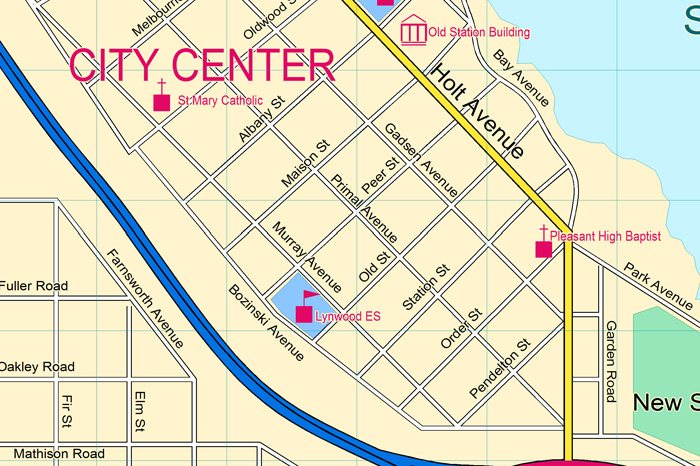
Modern City Street Map
ralf | March 24, 2011 | User Websites
Check out the beautiful maps of the World of Torn created by Natalya Faden.

1 Comment
Simon Rogers | March 21, 2011 | city planning
Location, Location, Location
by Steve Davies
Cities are one of the greatest environments for RPG adventuring. In a tight space, players can reasonably encounter every type of roleplaying challenge and meet each with a dizzying array of strategies and tactics. Cities can also be a gamemaster’s (GM) nightmare. It’s difficult to know where players will go next, detailed preparation is almost impossible, and everything should be available. To be successful, GMs need overall planning and a good city map. This series will get you started on the map and support your planning.
This is the first of a short series of articles on mapping cities for fantasy roleplaying games. I’ll show you the main considerations as you place, design, detail, and then play in the city. When we’re done, you’ll be able to draw out a reasonable city with confidence and present your players with an experience they won’t forget. I use ProFantasy’s Campaign Cartographer as my main mapping tool, and all of the maps are drawn with it. There is no post-processing on any of the maps.
I recommend that as you build your own city, that you keep a notepad at your elbow to record your thoughts and designs. Mapping is a creative process, and you will find that you generate many ideas for future adventures as you create your maps. Write the ideas down, and transfer as many of them to the map itself as you can. That way you can find them when you need them. So if you’ve just mapped a narrow pass that would be perfect for an ambush, add that encounter idea as a “GM-only” hidden note. If you don’t write them down in the moment, it’s often tough to remember or recreate the ideas later. And it’s great to be preparing for a gaming session and pull up the notes as a way through creative blocks. You will find that in city building, these notes are critical to make the city come alive later.
About Cities
Cities in the middle ages were rare. Fewer than a dozen true metropolises existed before the modern era. That is because a city needs the following things to grow and flourish:
- Abundant food and water to feed the population
- Water access: Either a navigable river or seaport
- Defense: Hills, river bends, and offshore islands all protect the riches of the city.
- Trade routes: Trade is the lifeblood of the city and where routes meet or goods transfer, cities grow.
The first task for anyone mapping a city is to find a suitable site for the city. On the map below, I’ve mapped the most likely places for a city to grow:
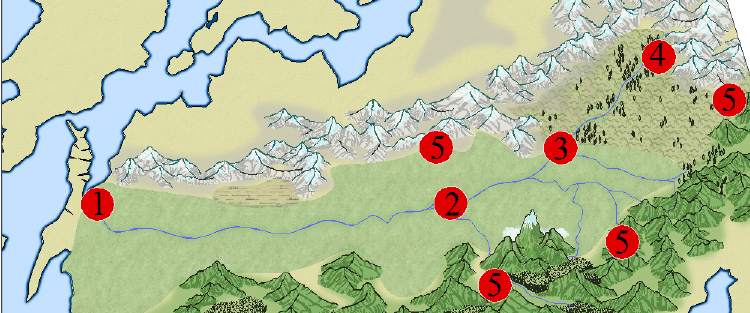 Continue reading »
Continue reading »
12 Comments
Simon Rogers | March 17, 2011 | city planning
Urban Planning
By Steve Davies
 If you’ve read our previous article, Mapping Cities 1, welcome back. If you just joined us, look at that first article, or just follow along from here. So far, we’ve found a place for the city, determined its size and laid out the general geography and boundaries.
If you’ve read our previous article, Mapping Cities 1, welcome back. If you just joined us, look at that first article, or just follow along from here. So far, we’ve found a place for the city, determined its size and laid out the general geography and boundaries.
Next, we’re going to add details to work up to an overview map of the city.
Major City Features
First, we need to place the major features of the city: Points of interest, major districts, entry points, roads, and other trade points. I generally cycle through these one by one, and continue going through the list until I am out of ideas. I’ll place these items on the map as labels or symbols to guide my further development. Here are some design considerations:
- Points of interest: This includes major buildings like courthouses, temples, and markets. Include government, business, religious, and entertainment points of interest. Usually a city will have all four types.
- Major Districts: I usually put in roughly one district per 1,000 people in the city. Wealthier districts take up more space (they are less dense). Put in labels for the districts if you have ideas, or leave them blank. The more affluent districts will be at the center of the city and along the major thoroughfares.
- Walls: Walls are expensive to build, but cities are valuable. Put in walls if the city is threatened, and expand the city outside the walls if there has been a period of peace.
- Entry Points: There should be a gate in the wall, or other way of collecting tolls, for every major direction from which people will enter the city.
- Roads: Roads will tend to parallel rivers and natural harbors; they will follow contours and attempt to rise evenly. Ridges will push the city into a longer form, often with a castle or temple at either end of the main street. On round hills, buildings cluster on top and roads tend to ring the hill.
- Trade: The city will thrive on trade. Make sure there are enough markets to cover everything for sale. But, don’t mix the cattle market in with the flowers, or even worse, ceramics and glass.
Continue reading »
2 Comments
ralf | March 6, 2011 | Caera, cartography, Dungeonslayers, game maps
Last week we played the first session of a German indie rpg: Dungeonslayers. As the name implies it’s a quick and easy, not quite old-school, Fantasy hack-and-slay (but not only) game. It’s a free download but can also be purchases in printed format at a very reasonable price. It’s worth it – we had a lot of fun.
The game comes with its own little setting called Caera. Its black-and-white maps are nothing to be sneered at, but of course they tickled my fancy and I set out to create my own CC3 version of the map. I loved creating this month’s Annual style (design by Jon Roberts) very much, so I decided to use it. Here it is: Continue reading »
15 Comments
Simon Rogers | January 27, 2011 |
This beautiful map was made using the Cartographer’s Annual Fantasy Map style found here by forum user Medio. You can follow its development on the forum.
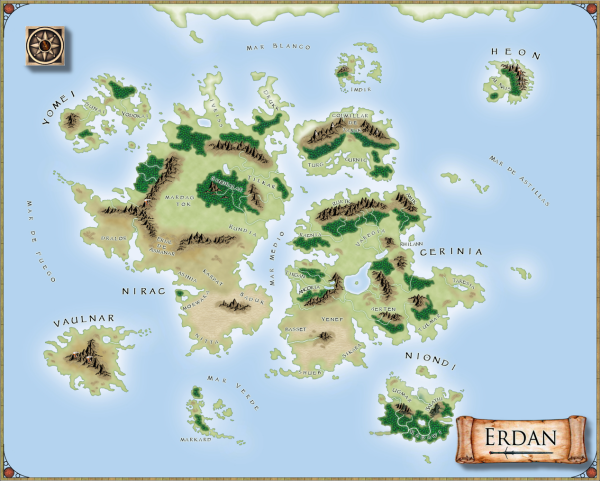
Close up:
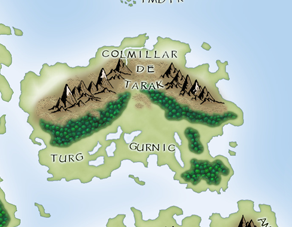 The political map:
The political map:
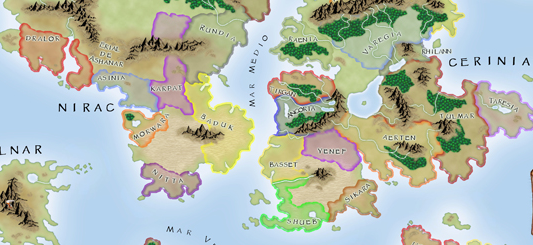
4 Comments
Simon Rogers | January 6, 2011 | publishing
I’ve been dealing with general customer queries for a couple of weeks while Ralf is on a well deserved holiday. Aside from the odd bit of tech support and registration enquiries I’ve had a few emails about licensing – that is, whether you can publish and/or sell the maps you create with Campaign Cartographer 3. The answer is simple: Yes, you can. You hold all the rights to the artwork you create with ProFantasy’s Software.
What you may not do, is re-distributing the artwork that we provide, i.e. the symbols and catalogs that come with the software. This includes maps that are created solely for the purpose of distributing symbols. We also include floorplan-resolution exports (eg PDFs) consisting predominantly of our artwork in this proviso.
Think of the symbols as a True Type font you have bought. You may create and sell documents created with that font, but you may not redistribute the font itself, or create a book of fonts.
6 Comments
ralf | December 21, 2010 | Albion, cartography, CC3, maps
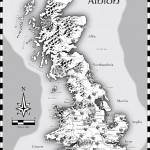
I recently had the pleasure to create a map for Silver Branch Games‘ upcoming Albion game.
Tim Gray had created a map for his setting in CC2 Pro a while ago and approached me at Dragonmeet for a re-working in one of CC3’s newer styles.
As it will be printed in black and white, we decided on the standard CC3 b&w vector style and this this the result. I’m pretty happy how it turned out:
Continue reading »
4 Comments







